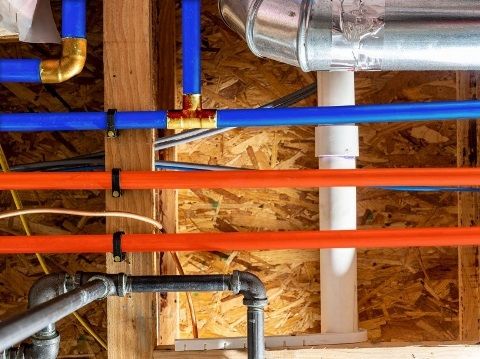- within Real Estate and Construction topic(s)
- with readers working within the Basic Industries and Property industries
Kitec piping was widely installed as an affordable and user-friendly alternative to traditional copper plumbing between 1995 - 2007. Kitec pipes are typically easy to spot, with bright orange pipes used for hot water and blue ones for cold.

Though not a familiar name to most, Kitec piping has become a serious concern in real estate transactions. The reason lies in its tendency to fail suddenly over time, often resulting in severe water damage. This issue has been extensively documented and continues to pose challenges for both buyers and sellers.
Due to the high failure risk, homes with Kitec piping often raise red flags with insurance companies and mortgage lenders. The presence of Kitec piping can negatively affect a property's market value, deter potential buyers, and even complicate the process of closing a sale.
Here's what buyers and sellers need to know to navigate this common but critical issue in real estate.
What is Kitec Piping and Why is it a Problem?
Kitec is a polymer pipe that was marketed in the late 1990s and early 2000s as a modern alternative to copper plumbing. Unfortunately, the materials used in Kitec systems have turned out to be unreliable over time.
The issues stem mainly from the brass fittings, which contain high levels of zinc. When exposed to water and oxygen, these fittings undergo a process called dezincification, a chemical reaction that breaks down the fittings, forming zinc oxide and causing blockages, corrosion, and ultimately pipe failure.
In addition, Kitec pipes have a maximum heat tolerance of 180°F (82°C). Hot water tanks, however, can sometimes exceed this temperature, further accelerating pipe degradation.
After mounting complaints and multiple failures, Kitec was recalled in 2005. Class action lawsuits were filed in both the U.S. and Canada, and while settlements are still being paid out, the window for filing claims has closed.
Is Kitec Piping Legally Required to be Disclosed?
While Kitec plumbing is no longer sold and its problems are well-documented, sellers and realtors alike can rest assured that there is currently no legal obligation to disclose its presence.
Real estate disclosure laws typically focus on what are known as "latent defects" which are issues with a property that are not visible or discoverable through a standard inspection and that may pose a risk to health or safety.
Because Kitec piping is often visible and identifiable during a routine home inspection, it is generally considered a "patent defect", not a latent one. As such, sellers are not required to disclose it, even if it has previously caused leaks or damage.
This means that buyers are at the mercy of the "buyer beware" principle. It's up to the buyer, and their inspector, to identify the presence of Kitec during the due diligence process.
That said, the legal landscape is not entirely settled. There's no definitive case law that outlines how all jurisdictions treat Kitec disclosure, and some cases may be evaluated individually, especially if the seller was aware of Kitec-related damage and failed to disclose it.
For Buyers: What to Watch Out For
- Ask your home inspector to check for Kitec plumbing. It's usually labeled "Kitec," "PlumbBetter," or "IPEX" and often has orange (hot water) or blue (cold water) flexible piping.
- Understand the risk. Even if it's not leaking now, failure can happen without warning. Many homeowners report issues within 10–15 years of installation.
- Factor in replacement cost. Depending on the size and layout of the home, replacing Kitec plumbing can range from $5,000 to $15,000+.
- Check with insurers and lenders. Some may not issue policies or mortgages unless Kitec is removed.
Tip: If you're buying a home with Kitec piping, you may be able to negotiate a lower price or request the seller offer a credit or complete the replacement of the piping prior to closing.
For Sellers: How to Handle Kitec Before Listing
If your home contains Kitec plumbing, transparency and strategy are essential to protect your sale price and avoid potential legal issues. While disclosure may not be legally required, proactively addressing the issue can help maintain buyer confidence and reduce the risk of future disputes or breach of contract.
Here are four common approaches sellers can take:
Option 1: Replace Affected Piping Before Listing
- Pros: Boosts buyer confidence, removes a common objection, and can prevent issues with insurance or mortgage approval.
- Cons: Replacement can be costly upfront, but may increase the home's value and reduce time on market.
Option 2: Disclose and Adjust Pricing
- Be transparent about the presence of Kitec piping and provide professional quotes for replacement.
- Consider offering a price reduction or a credit to the buyer at closing to cover the cost.
Option 3: List "As-Is" with Full Disclosure
- A suitable strategy in hot markets or when targeting investors or buyers planning renovations.
- Be ready for this to reduce the buyer pool or result in lower offers.
Option 4: Address Kitec in the APS
- Include a clause confirming the buyer acknowledges the presence of Kitec piping and agrees to take responsibility for any related costs.
- Alternatively, consider a replacement clause, where the seller agrees to replace the piping at an agreed-upon cost, paid by the buyer. This can make the home more appealing without requiring full upfront investment.
Tip: Some sellers have success including a pre-listing inspection that identifies the Kitec but also highlights that the home is otherwise in excellent condition. This builds buyer trust and helps control the narrative.
Bottom Line
Kitec plumbing doesn't have to derail your transaction as long as you handle it's presence in the right way. For buyers, knowledge is power. For sellers, taking proactive steps can help preserve, or even increase your home's market value.
The content of this article is intended to provide a general guide to the subject matter. Specialist advice should be sought about your specific circumstances.


